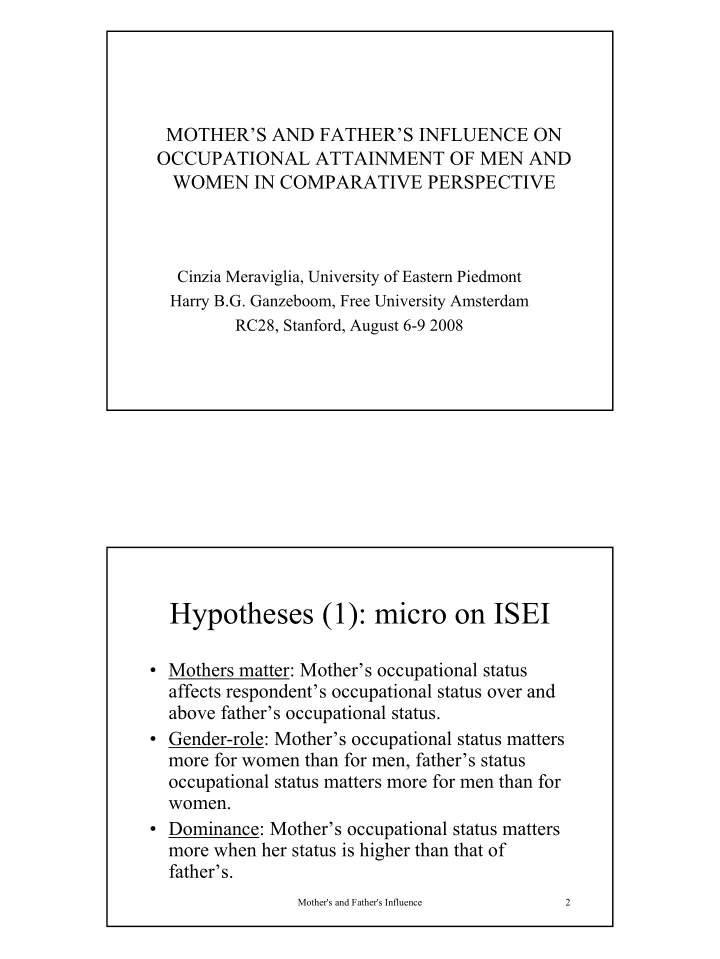

MOTHER’S AND FATHER’S INFLUENCE ON OCCUPATIONAL ATTAINMENT OF MEN AND WOMEN IN COMPARATIVE PERSPECTIVE Cinzia Meraviglia, University of Eastern Piedmont Harry B.G. Ganzeboom, Free University Amsterdam RC28, Stanford, August 6-9 2008 Hypotheses (1): micro on ISEI • Mothers matter: Mother’s occupational status affects respondent’s occupational status over and above father’s occupational status. • Gender-role: Mother’s occupational status matters more for women than for men, father’s status occupational status matters more for men than for women. • Dominance: Mother’s occupational status matters more when her status is higher than that of father’s. Mother's and Father's Influence 2
Hypotheses (2): Macro • Women’s status in society: Mother’s occupational status matters more (for women and men) in societies with less traditional gender roles. • Occupational segregation: Mother’s occupational status matters more (for women and for men) in societies with less gender segregation in the labor market. Mother's and Father's Influence 3 Design - micro • Individual data from 151 studies from 42 nations, harmonized in the International Stratification and Mobility File [ISMF]. • Initial N (age 21-64) 452.027 • Valid mothers 224.226 • Valid fathers 206.227 • Valid respondent (current/last) 190.142 Mother's and Father's Influence 4
Design - macro • Micro: OLS regression of occupational status with multiplicative interactions. • Macro: Cross-level interactions in OLS meta-analysis (second level regression). Mother's and Father's Influence 5 Measurement – macro (1) • SEGREGAT database of ILO: occupational gender distributions for a large number of countries, using various occupational classifications. • Data available with ISKO-88 classification for 40 nations (3 countries converted from national classification to ISKO-88). • Macro: dissimilarity indices: D, D s and A (see Charles & Grusky, 2004). Mother's and Father's Influence 6
Measurement – macro (2) • Gender Gap Index [GGI]: provided by World Economic Forum. • Measures female/male gaps in – (1) socio-economic participation, – (2) educational attainment, – (3) health and survival, – (4) political participation. • Available for 41 out of 42 countries. Mother's and Father's Influence 7 Measurement in ISMF - micro • Education: level measure, expressed in years. • Occupations classified in ISCO-68 and ISKO-88 (various levels of details) and scored by ISEI. Mother's and Father's Influence 8
Micro-models (1) A. Simple additive: FISEI + MISEI + FEMALE B. Gender-role: + FISEI*FEMALE + MISEI*FEMALE. C. Dominance: + FISEI*FDOM + MISEI*FDOM • With and without controlling education. • All models are estimated within countries + for the pooled data (controlling country dummies). Mother's and Father's Influence 9 Equivalent micro-models (2) A. ( FISEI+MISEI) + (FISEI-MISEI) + FEM. B. (A) + (FISEI+MISEI)*FEM + (FISEI-MISEI)*FEM. C. (B) + (FISEI+MISEI)*FDOM + (FISEI- MISEI)*FDOM. • These models are just another expression of the same parameters. Mother's and Father's Influence 10
Model parameters A B C Intercept 31.465 27.123 27.754 28.521 5.336 (165) (138) (130) (122) (24.9) FEMALE 0.677 0.626 -0.659 -0.685 0.670 (10.5) (9.9) (-3.7) (-3.8) (-4.4) FISEI 0.375 0.257 0.277 0.208 0.098 (157) (91.8) (-71.1) (30.5) (-16.9) MISEI 0.218 0.178 0.216 0.059 (76.6) (44.9) (36.5) (-11.7) FIS*FEM -0.039 -0.039 -0.033 (-7.3) (-7.2) (-7.2) MIS*FEM 0.081 0.081 0.047 (-14.6) (-14.7) (-10) DOMINANCE -1.715 0.109 (-9.0) (-0.6) FIS*DOM 0.122 0.014 (-15.8) (-2.1) MIS*DOM -.089 -0.007 (-11.4) (-1.0) EDUCYR 2.537 (-278) Adj. R2 21.28% 23.64% 23.72% 23.84% 45.96% Results (1) (pooled data) • Net total effect of MISEI is about 80% of FISEI. • Total effect of family background is under- estimated by 12% if we use only FISEI. • Gender-role effect is present for both men and women; it is about twice as strong for mothers as for fathers. • Dominance effect is strongly present, but completely disappears when education is controlled. Mother's and Father's Influence 12
Results (2) (countries) • Improved by + MISEI: Mean ratio: 1.12. SD(ratio) = 0.06. • B(fisei) > B(misei): 32/42 countries. • FEM*FISEI < 0 32/42 countries • FEM*MISEI > 0 33/42 countries • FISEI*DOM > 0 25/42 countries • MISEI*DOM < 0 22/42 countries Mother's and Father's Influence 13 Macro-analysis • Is the relative size of effect FISEI versus MISEI conditioned by macro-level variables ‘Charles’ (Charles & Grusky’s new segregation index) and/or GGI (Gender Gap Index)? Mother's and Father's Influence 14
Correlations Awithin Abetween charles GGI Awithin Pearson Correlation 1 .087 .656 -.108 Sig. (2-tailed) .810 .039 .766 N 10 10 10 10 Abetween Pearson Correlation .087 1 .261 .551 Sig. (2-tailed) .810 .466 .099 N 10 10 10 10 charles Pearson Correlation .656 .261 1 .176 Sig. (2-tailed) .039 .466 .298 N 10 10 37 37 GGI Pearson Correlation -.108 .551 .176 1 Sig. (2-tailed) .766 .099 .298 N 10 10 37 41 Mother's and Father's Influence 15 Mother's and Father's Influence 16
Mother's and Father's Influence 17 Mother's and Father's Influence 18
Macro-correlation -- weighted GGI charles d_fmis -0.131 0.052 Mother's and Father's Influence 19 Conclusions • Mothers do matter. • More for women, but also for men. • Sex-role modelling is also present for fathers, but less strong than for mothers. • Dominance effects are present, but appear to be restricted to education (indirect effect). • Macro-variables do not contribute anything to explaining between-country variation in relative effect father/mother. Mother's and Father's Influence 20
Recommend
More recommend